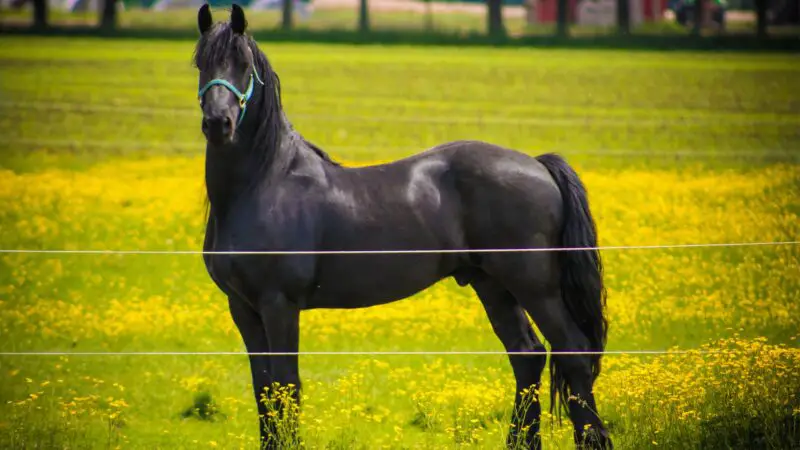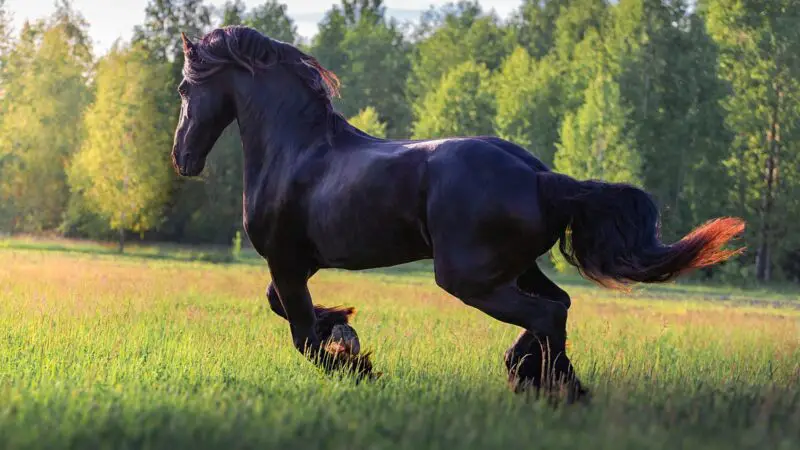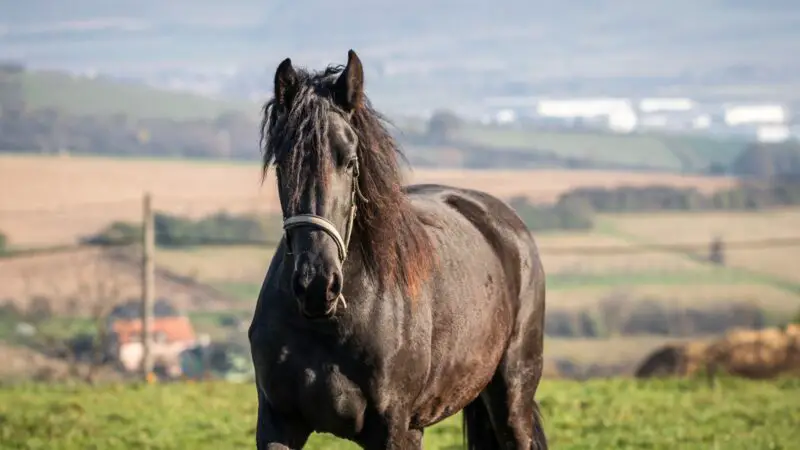Although it has its challenges, owning a horse is a fun, rewarding, and therapeutic experience as long as you are managing them properly. Selecting a breed is the most important decision you can make in this endeavor, and what better horse is there than the multi-purpose Friesian horse?
Friesian horses are compact, strong-bodied, and elegant-looking horses that originated from the province of Friesland in the Netherlands. Friesian horses are generally solid black and can serve a variety of purposes such as riding, driving, carriage-pulling, dressage, competition, and farm work.
This article discusses everything you need to know about Friesian horses, their history, appearance, distinctive characteristics, and other interesting information. Read this article further for more!
Friesian Horse History

Friesian horses descended from the “Great Horses” that were native to Northern Europe. These animals were described to be strong and fast enough to carry crusade knights. During the 17th century, Dutch horses and Andalusian horses were crossbred resulting in the creation of the Friesian breed.
Despite being widely exported throughout Europe and utilize as a means of improving a wide variety of other horse breeds due to their highly desirable trotting ability, Friesians remained free of outside blood, making them a genetically distinguishable member of the warm blood group of horses.
These horses were introduced to North America in the 1600s by Dutch settlers. In the 1900s, the Friesian faced the brink of extinction as the market for multipurpose horses drastically decreased. Only 500 Friesian horses remained by the middle of the 1900s. However, in the 1970s, the breed was reintroduced in the country by driving enthusiasts.
In 1983, the Friesian Horse Association was founded in the United States. Today, there are approximately 60,000 Friesians worldwide, most of which are found in the Netherlands. As of 2014, there are an estimated 8,000 horses in the US.
Friesian Horse | Identification

What Do Friesian Horses Look Like?
Compact and strong-bodied horses that are solid black may also be blue, gray, roan, chestnut, or blue silver dapple. They have a powerful form and great bone structure with chiselled heads, short ears, and long necks.
Their best characteristic is their long mane and tail, which often reach the ground. They also have abundant feathering and hairs on their lower legs.
How Long Does a Friesian Horse Live?
Friesians live up to 16 years, but some individuals may live up to 20 years, which is considerably less than other horse breeds, which live up to 30 years. This may be because Friesian bloodlines were kept as pure as possible, which meant that they weren’t crossbred with other breeds that have better longevity and hardness.
What Do Friesian Horses Eat?
Friesian horses eat hay, grass, roughage, grains (oats, corn, and barley), protein supplements (cottonseed, soybeans, peanut meal, rapeseed, sunflower seed meal), limited quantities of weeds such as dandelions and thistles, and fruits and vegetables such as carrots, bananas, green beans, celery, watermelon rinds, and squash.
How Big Do Friesian Horses Grow?
Friesian horses have a standing height of 58 to 68 inches at the withers.
Are Friesian Horses a Heavy Breed?
Friesian horses are not a heavy breed. They are of average weight, with adults weighing around 1,200 to 1,400 pounds.
What Is Friesian Horse Known For?
Friesian horses are multipurpose animals used for riding and driving for pleasure, dressage, competition, farm work, pulling carriages, and trail riding.
Where Do Friesian Horses Originate?
They originate from the province of Friesland in the Northern Netherlands. Friesians were first mentioned in the 11th century when they were widely used by Friesian knights and troops.
What Are the Distinct Characteristics of a Friesian Horse?
Friesian horses are known for their fleet-footed, high-stepping trot due to their short but strong limbs and sloping hindquarters. They carry their heads high and have expressive faces, giving an overall elegant air to them.
Friesian Horse Temperament
Friesian horses have an excellent disposition as they are active, willing, and energetic but are otherwise very gentle and docile animals.
How Much Does a Friesian Horse Cost?

Friesian horses cost around $3,000 to $200,000 depending on the age, sex, and if they are registered as breeding stallions.
Tips for Taking Care of Friesian Horses
Housing
Friesian horses should be kept outside and only moved to a shelter for protection against excessive heat, cold, and precipitation. It’s more cost-efficient if the horses are kept on your property instead of boarding. Whatever type of housing you get for your horses, make sure they have access to at least small acreages.
Grooming
Use a rubber currycomb when beginning the grooming process, a shedding blade to remove excess or shedding hair, stiff brushes to loosen and remove hair and dirt, and soft brushes to place the finishing touches on the horse. Hoofs should regularly be cleaned and trimmed daily or reshod every 4 to 6 weeks.
Nutrition
Along with commercial grain mixes or complete feeds, provide high-quality hay and roughage for your Friesian. Vitamin-mineral and protein supplements should also be added to the horses’ diet. Make sure the horses have access to fresh, clean water at all times.
Nutrient requirements depend on the amount of work a horse does daily. Here’s a guide to help you know how much to feed your horse:
| Amount of Work Done | Hay | Grain |
| No work | 20 to 25 pounds | None |
| Light work (1 to 2 hours a day) | 15 to 20 pounds | 1 to 3 pounds |
| Medium work (2 to 4 hours a day) | 15 to 20 pounds | 3 to 8 pounds |
| Heavy work (4 or more hours a day) | 15 to 20 pounds | 5 to 10 pounds |
Feeder
There are several types of feeders that you can choose from based on the level of hay wastage, intake, and payback they can provide. Some designs include cinch net, waste less, hay hut, covered cradle, tombstone saver, cone, ring, and hay sleigh. When unused, cover the feeder with plastic wrap, twine, or net wrap to reduce wastage and weathering.
Pasture Management
This is important since pastures mainly supply the nutrition horses need. Adding nitrogen-based fertilizer to your pasture will help it become healthy and productive. Mow the pasture to maintain a uniform look and generate dense and leafy vegetation. Forage height should be 2 to 3 inches if the pasture is composed of short-grass species and 3 to 5 inches for taller species.
Remove weeds as much as possible, as they are toxic and harmful to the horse’s health. They also compete with nutrients, space, water, and light with desirable grasses.
Cleanliness
Compost or remove and spread manure to reduce the areas where flies, ticks, and mosquitoes breed. Clean water tanks regularly and limit the amounts of standing water, such as in drainage areas, water in old tires, and unused buckets. Remove any brushy areas in the horse’s pasture.
Health
Your horses should get routine examinations to check for any health issues as well as receive vaccinations. Your Friesian should be able to receive 5 core vaccines in their annual exams, and these are for: West Nile virus, rabies, tetanus, and Eastern and Western Equine Encephalomyelitis. They should also be dewormed if there are present parasite populations.
Is It Expensive to Raise Friesian Horses?
It is expensive to raise Friesian horses since the cost of the horse alone is already a hefty amount. Annual costs are a minimum of $2,500 and can be as high as $5,000. This includes costs for feed, pasture maintenance, veterinary and medicine, bedding, farrier, building maintenance, and training.
How Much Space Does a Friesian Horse Need?
A Friesian horse needs at least 400 square feet of a dry lot or shelter space, a 12-foot by 12-foot stall, and 1 ½ to 2 acres of open land for foraging.
Friesian Horses Common Health Issues

- Dwarfism. This is a genetic disorder in Friesian horses characterized by a reduced bone length of the ribs and limbs. It is quite a common occurrence for the breed and has no treatment, but the affected horses can still live a good quality of life.
- Hydrocephalus. Caused by an excessive accumulation of brain fluids, this genetic disease results in severe distention of the head, making it look large and domed. Affected foals are usually stillborn, aborted, or born with severe neurological issues.
- Megaesophagus. Friesian horses are prone to this disease which is characterized by weak muscle tone, appetite loss, salivation, and obstruction in the esophagus which may lead to pneumonia and aspiration.
- Dermatitis. This causes lesions and ulcerated skin on the horses and is often unresponsive to skin treatments.
Related Questions
How Fast Can a Friesian Horse Run?
Friesian horses can run an average of 25 to 30 miles per hour, depending on the distance. They are quite agile and quick depending on their large and hairy appearance.
Are Friesian Horses Good for Beginners?
Friesian horses are good for beginners because they have a calm and friendly disposition. Additionally, they are made for a variety of uses, not just for riding and driving, making them a good fit for all types of riders, regardless of their level of expertise.
Are Friesian Horses Good for Riding?
They can be used for riding both for pleasure and in competition.
What Age Can a Friesian Be Ridden?
They can be ridden when they reach 2 years of age as they reach maturity at 5 or 6 years.
Can Friesian Horses Be White?
They only come in a solid black color although they can be blue, gray, and chestnut these are rare.
Are Friesian Horses Cold-Blooded?
Friesian horses are warm-blooded animals since they are a cross between a cold and hot blood horse.
Are Friesian Horses Rare?
Friesian horses are not rare, although they were almost extinct at the start of the 20th century. Thanks to breeding efforts, there are now a total of 60,000 Friesians worldwide.
Are Friesian Horses Intelligent?
Friesian horses are extremely intelligent. They are also willing to learn and are highly trainable horses.
What Is the Difference Between an Andalusian and a Friesian Horse?
| Characteristics | Andalusian Horse | Friesian Horse |
| Appearance | White or light gray in color | Solid black in color |
| Height and weight | 59 to 62 inches; 900 to 1,200 pounds | 58 to 68 inches; 1,200 to 1,400 pounds |
| Purpose | Driving, bullfighting, show jumping, and dressage | Riding and driving for pleasure, dressage, competition, farm work, pulling carriages, and trail riding |
List of Sources
Bulletin #1004, Equine Facts: Guide to First-Time Horse Ownership
